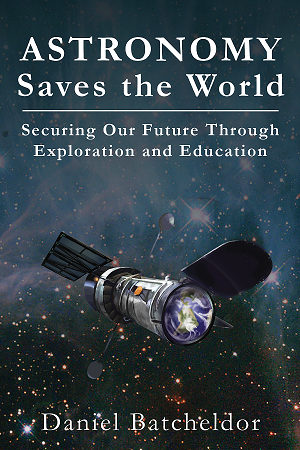Selected
Publications
Astronomy Saves the World
Securing Our Future Through Exploration and Education
 Astronomy Saves the World details the avoidable and unavoidable threats to our existence, and
provides the case for astronomy being part of everyone's education. Astronomy will ensure our
planet never again experiences a catastrophic cosmic impact from an asteroid or comet, and has
shown that these ancient harbingers of death are now rich resources waiting to be reaped.
Astronomy will lead us forward, away from an evolving sun, as we migrate throughout our solar
system and beyond.
Astronomy Saves the World details the avoidable and unavoidable threats to our existence, and
provides the case for astronomy being part of everyone's education. Astronomy will ensure our
planet never again experiences a catastrophic cosmic impact from an asteroid or comet, and has
shown that these ancient harbingers of death are now rich resources waiting to be reaped.
Astronomy will lead us forward, away from an evolving sun, as we migrate throughout our solar
system and beyond.
But our future is hopeless without a well-informed and cohesive global society.
We all need the sense of wonder and cosmic humility that astronomy instills.
It is the great educational motivator regardless of demographic, and it is rich
with history, science, art, engineering, music, and mathematics.
It is the lesson for all humankind. Astronomy can be the key to comprehensive
emancipation via education and provide us a united path into the deep future.
- Available from Amazon in hardcover, Kindle, and audiobook formats.
- Available from Spacewalk Publishing in DRM-free e-book and audiobook formats.
Additional Publications
Batcheldor, D at ADSBatcheldor, D at Astro-ph
Tadhunter, C. et al. 2018arXiv180500514T Quantifying the AGN-driven outflows in ULIRGs (QUADROS) II: evidence for compact outflow regions from HST [OIII] imaging observations
Palotai, Cs. et al. 2018arXiv180105072P Analysis of June 2, 2016 bolide event
Cannon, K. et al. 2017AGUFM.P31A2803C Developing a High Fidelity Martian Soil Simulant Based on MSL Measurements: Applications for Habitability, Exploration, and In-Situ Resource Utilization
Keel, W. et al. 2017PASP...129a...5002K. The Remote Observatories of the Southeastern Association for Research in Astronomy (SARA).
Graham, A. et al. 2016ApJ...819...43G. A Normal Supermassive Black Hole in NGC 1277.
Batcheldor, D. et al. 2016PASP...128b...5001B. Extreme Contrast Ratio Imaging of Sirius with a Charge Injection Device.
Vazquez, B. et al. 2015ApJ...801..127V. Spitzer Space Telescope Measurements of Dust Reverberation Lags in the Seyfert 1 Galaxy NGC 6418.
Lena, D. et al. 2014ApJ...795..146L. Recoiling Supermassive Black Holes: A Search in the Nearby Universe.
Rodríguez Zaurín, J. et al. 2014A&A...571A...57R. Extended warm gas in the ULIRG Mrk273: Galactic outflows and tidal debris.
Ramírez, E. A. et al. 2014MNRAS...444...466R. Near-infrared Hubble Space Telescope polarimetry of a complete sample of narrow-line radio galaxies.
Bosh, A. et al. 2013DPS...45...40401B. The State of Pluto's Atmosphere in 2012-2013.
Batcheldor, D. et al. 2013AJ...146...67B. An STIS Atlas of Ca II Triplet Absorption Line Kinematics in Galactic Nuclei.
Batcheldor, D. et al. 2011ASPC..449...44B. High Accuracy Imaging Polarimetry with NICMOS.
Batcheldor, D. et al. 2011ApJ...738...90B. NICMOS Polarimetry of "Polar-scattered" Seyfert 1 Galaxies.
Hammer, D. et al. 2010ApJS, 191, 143H. The HST/ACS Coma Cluster Survey. II. Data Description and Source Catalogs.
Batcheldor, D. et al. 2010, ApJ, 717, L6. A Displaced Supermassive Black Hole in M87.
Batcheldor, D. 2010, ApJ, 711, L108. The M-Sigma Relation Derived from Sphere of Influence Arguments.
Batcheldor. D.; Koekemoer, A. M. 2009, PASP, v121, i885, pp.1245. The Future of Direct Supermassive Black Hole Mass Estimates.
Ramrez, E. et al. 2009, MNRAS, v339, i4, pp.2165. The nature of the near-infrared core source in 3C 433.
Batcheldor, D. et al. 2009, PASP, v121, i876, pp.153. High Accuracy Near-infrared Imaging Polarimetry with NICMOS.
Koekemoer, A. M. et al. Astro2010: The Astronomy and Astrophysics Decadal Survey, Science White Papers, no. 157. Tracing the Mass Buildup of Supermassive Black Holes and their Host Galaxies.
Batcheldor, D. Memorie della Societa Astronomica Italiana, v.79, p.1239 (2008). The M-Sigma Project.
Carter, D. et al. 2008, ApJS, v176, i2, pp.425. The Hubble Space Telescope Advanced Camera for Surveys Coma Cluster Survey. I. Survey Objectives and Design.
Batcheldor, D. et al. 2007, ApJ, v663, i2, pp.L85. How Special Are Brightest Cluster Galaxies? The Impact of Near-Infrared Luminosities on Scaling Relations for BCGs.
Pastorini, G. et al. 2007, A&A, v469, i2, pp.405. Supermassive black holes in the Sbc spiral galaxies NGC 3310, NGC 4303 and NGC 4258.
Batcheldor, D. et al. 2007, ApJ, v661, i2, pp.70. Dominant Nuclear Outflow Driving Mechanisms in Powerful Radio Galaxies.
Batcheldor, D. et al. 2006, PASP, v118, i842, pp.642. The NICMOS Polarimetric Calibration.
Merritt, D. et al. 2006, MNRAS, v367, i4, pp.1746. The nature of the HE0450-2958 system.
Batcheldor, D. et al. 2005, ApJS, v160, i1, pp.76. Integral Field Spectroscopy of 23 Spiral Bulges.
Hughes, M. A. et al. 2005, AJ, v130, i1, pp.73. Nuclear Properties of Nearby Spiral Galaxies from Hubble Space Telescope NICMOS Imaging and STIS Spectroscopy.
Atkinson, J. W. 2005, MNRAS, v359, i2, pp.504. Supermassive black hole mass measurements for NGC 1300 and 2748 based on Hubble Space Telescope emission-line gas kinematics.
Hughes, M. A. et al. 2004, IAUS, No.222, p.181. Nuclear clusters, bulges and massive black holes in spiral galaxies.
Batcheldor, D. et al. 2004, IAUS, No.222, p.73. Host bulge properties: The key to SMBH mass estimates?
Scarlata, C. et al. 2004, AJ, v128, i3, pp.1124. Nuclear Properties of a Sample of Nearby Spiral Galaxies from Hubble Space Telescope STIS Imaging.
Hughes, M. A. et al. 2003, AJ, v126, i2, pp.742. An Atlas of Hubble Space Telescope Spectra and Images of Nearby Spiral Galaxies.
Marconi, A. et al. 2003, ApJ, v586, i2, pp.868. Is There Really a Black Hole at the Center of NGC 4041? Constraints from Gas Kinematics.